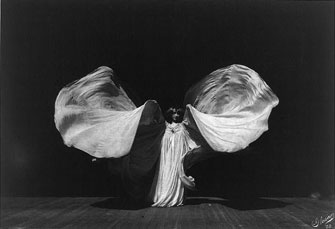Is It a Butterfly? An Orchid? No. It’s the Light Fairy

Nearly 120 years after her triumphal first performance in Paris, Loie Fuller is still working her magic in the Centre Pompidou’s “Dansez sa Vie” exhibition, where a silent colorized film produced by the Lumière brothers shows an unnamed woman performing Fuller’s famous “Serpentine Dance,” with its dizzying rippling and whirling of hundred of yards of lighted silky fabric. There are no moving images of Fuller performing her own dances, but it is easy to understand from this one the effect her live performances had on fin de siècle audiences. The exhibition explores Fuller’s legacy in the history of the abstraction of the body and her influence on early-20th-century visual artists.
How did this petite (five feet two), plumpish, cherub-faced autodidact become one of the most famous dancers of her time? American vaudeville performer Loie Fuller, or La Loïe, as she became known in Paris, where she arrived in 1892, had been born Marie-Louise Fuller outside of Chicago in January 1862 and first stepped onto the stage at a Sunday school assembly when she was two-and-a-half years old. She dreamed of becoming a world class thespian and opera singer, but it was the “Serpentine Dance” that sealed her fame.
Fuller sowed the seeds of this dance while playing a floating spirit in a minor play in 1891. She was flitting across the stage in a hypnotic trance, enveloped in a loose pongee silk robe, flailing her draped arms up and down, when someone in the audience yelled “A butterfly!” When she twirled on herself, someone else yelled “An orchid!” The audience roared. Fuller claimed to have created her new dance in her hotel room, observing the play of the curtain-filtered sunlight on the moving silk of her gown.
In Paris, she fast became the muse and the iconic femme-fleur of the Art Nouveau movement. Her performances offered Parisians a new vision of the feminine aesthetic, free of the stultifying constraints of ballet and the erotic vulgarity of the music hall. Everyone went to see “La Fée Lumière” (the Light Fairy) at the Folies Bergère. “Is she pretty?” asked a journalist. His answer echoed the fantasies of all who came to see her dance. “She doesn’t need to be. She is superior to life itself… an idealized, seductive, unreal creature.”
The 1900 Paris Universal Exposition consecrated Fuller as the high priestess of electricity and Art Nouveau. “I retain one vibrant image from the Exposition Universelle,” Jean Cocteau wrote, “Madame Loie Fuller….”
Affable, prodigal and generous, Fuller was the most painted, sculpted, lithographed and photographed artist of her time and was also a one-woman multimedia enterprise. She ran her own dance school, co-founded two museums in the United States and promoted relief work with her performances during WWI. She made a lot of money, yet died virtually bankrupt.
Fuller was an indefatigable experimenter. Her sophisticated light-projecting apparatus and colored glasses required the services of two dozen electricians. She eliminated backdrop and scenery and was the first to dim the houselights before her performances. For her “Danse du Feu,” she invented underlighting, with glass plates built into the stage floor to give the effect of a giant blaze rising and gradually turning her into living fire.
A glass pedestal made her appear to be dancing suspended in air. When she emerged out of pitch blackness engulfed in a swirl of moving colors and morphed herself into a blooming lily, an unfolding butterfly, or a raging fire, audiences gasped.
A more prosaic source of her “Serpentine Dance” was skirt-dancing, a popular feature of burlesque shows in the late 1800s that combined step-dancing and acrobatic kicks in a large skirt of light, pleated fabric designed to show curves and legs. Fuller saw beyond the suggestive aspect of the dance and began to enlarge the skirt until the moving fabric became the dance itself, obscuring the dancer within. Using colored lights projected on to the moving fabric, she whirled in illuminated yards of silk, which she maneuvered in great sweeps and billows by means of long bamboo or aluminum wands held at arm’s length.
For her “Mirror Dance,” a lighted octagonal mirrored structure duplicated the dancer in myriad images of herself. “Eight Loie Fullers appear to be dancing at the same time,” recalled one spectator. Isadora Duncan was “entranced”: “She could do orchids, seaflowers, lilies, metallic snakes, sparkling gems – all the magic of Merlin.”
Fuller built her own laboratory to experiment with light-producing phosphorescent salts to paint on her fabrics and create glow-in-the-dark effects. One experiment blew up the lab and singed everyone’s eyelashes and brows. Her technologically amped-up performances initiated a revolution in stagecraft and lighting design and established a new context for dance.
Fuller liked to say that she was born in America but made in France. She was to reign supreme on the stages of Europe and the world – invitations came from as far away as the imperial court of China – until her death in 1928.
She had choreographed a total of 128 dances but, despite her many imitators, fell into undeserved obscurity after her death. However, her legacy as a mixed media pioneer is rising again. “I am certain of being followed, and someday someone will realize the theater of light, of which I have dreamed,” Fuller said in a 1923 interview. She does indeed have followers: dancers ranging from Alwin Nikolais to Dawn Stoppiello, Philippe Découffé and Jody Sperling (a Fuller reinterpreter) have turned to new technology to create the illusions Fuller strove to attain throughout life.
Marcelline Dormont
Reader William (Rick) Benshoof writes: “Fascinating article. I would say that few have come close in matching Loie Fuller in creativity. Madame Dormont, in a brief article, does much to illustrate Fuller’s genius. And I thank her for bringing this subject to our attention.”
Favorite